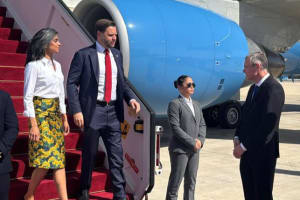Gaza’s post-war economy: Ceasefire brings lower prices, sees increase in black market trading
Apple iPhone 17 costs between ~$8,000 to $10,000 in Gaza Strip

Many residents of the Gaza Strip were unemployed during the war, and it is now becoming clear that there is a severe cash shortage in the region.
This is creating a phenomenon of trading in physical cash, which has become much more valuable than bank transfers. Much of the money used in this trade comes from donations from abroad.
Kan News reported on Sunday that there has been a dramatic drop in prices following the implementation of the ceasefire. A bag of pasta that cost 50 shekels before the ceasefire now costs 20 shekels. A kilo of sugar dropped from 60 shekels to just 5 shekels. A kilo of flour plummeted from 120 shekels to 5 shekels, and canola oil dropped from 120 shekels to 10 shekels.
Chicken and meat, which were unavailable during the war, have returned to the markets at a price of 130 shekels per kilo—a price that might seem reasonable by Israeli standards, but is unaffordable for most Gaza residents.
A Gaza resident told reporters: "The prices today are good, but there's no money. There's no money—where is the money? In Gaza today, there’s nothing. Two years with no work, no factories, nothing. Everyone relies on aid. Today, merchants brought in goods, but the only ones who can buy are those who have relatives abroad—in Saudi Arabia, here, there—sending 100 dollars, 50 dollars, 30 dollars."
A surprising phenomenon that has emerged is the trade in physical banknotes. A Gaza resident explained, "If I want half the amount—someone who lends will take half of the shekels, which I’ll pay him digitally, so he can give me cash. He deducts half the amount and profits the other half. In other words, he sold me cash—he's trading in cash."
This cash trade inflates the price of many products. These products are smuggled into the strip via humanitarian aid trucks. The iPhone 17, which was released just last month, arrived in Gaza surprisingly fast—even during the war, before reaching some places in Israel and around the world. The iPhone 17 in Gaza is estimated to cost between 32,000 to 39,000 shekels (~$8,000 to $10,000).
A Gaza resident explained the smuggling process: "Today they smuggle goods through shipments coming from Egypt and Israel. There's aid coming in from Egypt; they smuggle in drugs, cigarettes. Today, cigarettes are cheap—a pack costs 30, 40, 50 shekels. One cigarette used to cost 200 shekels. The price dropped due to smuggling."
However, after the ceasefire took effect, prices dropped slightly, partly due to the increased rate of aid entering Gaza. Still, for most residents—who lost their livelihoods during the war—even the reduced prices remain unaffordable.
Anastasia Stukanov is a KAN 11 News correspondent.
You might also like to read this:

















